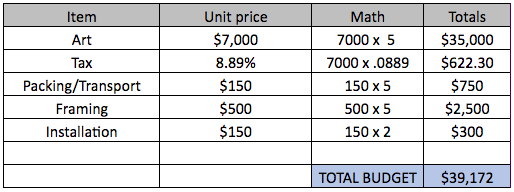Last week’s inaugural Inside the Art World column touched on how to get your clients on board with art buying—it’s the first step in effectively sourcing art and accordingly finishing a space and increasing revenue. Today’s column addresses step two: developing an art budget.
Now how to create this budget is a big fat question mark for many, because clients often don’t know how much is appropriate to allocate, and the price of art ranges quite a bit. By “quite a bit,” I mean from $0 to more than $450 million. Fortunately for the world, prices in the seven to nine digits are the outliers and excellent art can be acquired at the very low end of the scale. Here are the costs to consider when creating an art budget for clients:
- Art
- Tax (if applicable)
- Packing and transport
- Framing
- Installation
My strategy for assigning numbers to each of the above is to know my client and local market, and then make informed assumptions. Let’s say my client is comfortable spending up to $10,000 on a piece of art and has five walls to fill of varying size and importance. Art for the smaller and less important spaces will likely cost less than art for the larger, more important places. Accordingly, let’s assume an average cost per artwork of $7,000.
Determining the sales tax percentage is straightforward.
For the packing, transport, framing and installation, I use the following assumptions, which you can use or adjust based on your local market (and galleries can help you determine such costs):
- Packing and transport within New York City: $150
- Framing: $500 per piece
- Installation: $150 per hour, with three pieces installed per hour
Note that framing costs are variable depending on size, materials, matting and whether a piece should be framed behind glass (and the quality of glass selected). New York frame costs are also higher than in other regions, but assuming $500 per piece has proven to work for me. Some pieces are much more, and some don’t require framing. Plus, I always prefer to make conservative assumptions and come out under budget.
The numbers and assumptions can be easily figured into the following table to determine an appropriate budget:

Of course, this is all easily adjustable, and adding in a line for “commission” is simple. If your client isn’t comfortable with the final number, you can cut in other areas—lowering the average cost per piece (maybe you do low-cost wall decor for one of those five walls, thereby driving down the average price per art), or having pieces transported together to reduce the total transport spend.
In my next column, we’ll be chatting about techniques for pitching art to clients, because, let’s face it, sending over endless options gets old fast.
I welcome you to share your thoughts and any aspects of working in the art world you’d like to see in future posts.
Katharine Earnhardt is the president and founder of Mason Lane Art Advisory, a Brooklyn firm that styles walls nationwide.



























